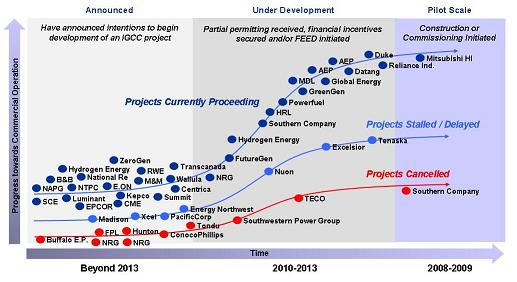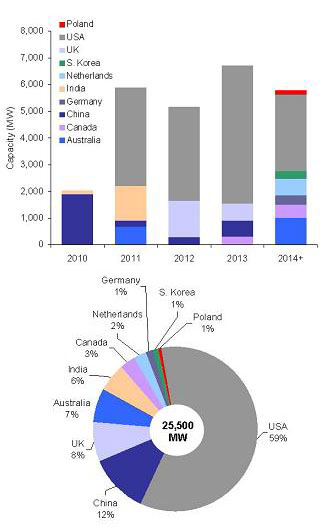IGCC's Future Hinges on Workable Carbon Framework
Cambridge, USA – One of the leading alternatives for producing clean power from coal – Integrated Combined Cycle Gasification (IGCC) technology faces a precarious future due to rising capital costs and regulatory uncertainty. A process of gasifying coal that allows capture of carbon dioxide emissions, IGCC has tremendous potential for meeting future baseload generation demand but project momentum has slowed dramatically in 2007, according to a new study from Emerging Energy Research (EER). Despite delays or cancellations of several prominent IGCC projects in 2007, 48 projects with a combined capacity of over 25,000 MW remain in the global IGCC pipeline, according to EER.
“Natural gas price volatility, concerns over climate change, and heightened attention to damaging pollutants continue to drive interest in IGCC,” according to EER Senior Analyst Alex Klein. “It has become abundantly clear that if coal is to remain a staple of new build power generation, technologies that mitigate carbon dioxide emissions will be required. IGCC leads these technologies for its low cost potential to capture a significant percentage of its carbon dioxide emissions at commercial scale,” says Klein.
To become a realistic option for widespread power generation, long-term stable carbon policies are needed to see IGCC project roll-out build momentum, according to EER. As climate change concerns, have dramatically curtailed traditional coal power generation, the industry has shifted attention to clean coal alternatives such as IGCC that are able to capture CO2. Without established legislative frameworks for sequestration, however, or a clear view of how the additional costs of capture can be recovered, IGCC development will continue to stagnate, according to EER.
IGCC developers continue to face short-term challenges
On balance, 2007 has been a disappointing year for IGCC project developers with 11 projects cancelled during the year representing some 7,000 MW of generating capacity, according to EER. The pace of development of the existing project pipeline also slowed considerably.
“While overall confidence in IGCC as a commercial technology has improved considerably, the difficult market environment facing all new build coal use outside of China and India–including escalating capital costs and carbon policy uncertainty–has dampened IGCC market activity and competition,” according to Klein.
Status of Global IGCC Project Pipeline

Still, several significant energy companies including Edison Mission, NRG, BP, Rio Tinto, Centrica and Babcock & Brown have announced intentions to explore investments in IGCC projects. Vertically integrated utilities (such as Duke, AEP, and Southern) currently represent the largest share of IGCC project developers, however, IGCC activity is shifting to entrepreneurial developers and IPPs who are better positioned to take on short-term carbon policy and sequestration market risks, according to Klein.
These new players are increasingly attracted to regions with attractive Enhanced Oil Recovery (EOR) opportunities as CO2 off-take prices are expected to increase, driven by escalating oil prices, helping to off-set much of the additional costs of investment of carbon capture and transport.
US leads global development of IGCC by a long shot
Currently, 25,500 MW of IGCC projects in the global pipeline are under development in 10 different countries, with the overwhelming concentration of IGCC development underway in the US, according to EER.
The US accounts for nearly 60% of the current coal- and/or petcoke-based IGCC projects under consideration globally. On the back of significant financial support from federal and state governments, the US is leading commercialization efforts of IGCC globally with 26 projects at some stage of development in 17 states with a combined capacity of just over 15,000 MW.
While the US will continue as the most significant market in terms of IGCC activity, notable increases in project development can be expected from Western Canada, Australia and China. Australia is following in the footsteps of the US, boosted by strong state and federal policies targeting clean coal technologies. IGCC development is also growing in Western Canada, driven by EOR opportunities. In China, as air quality becomes a greater threat to economic development and as gasification experience develops for chemicals and fuels production, confidence in IGCC technology is growing. Europe is expected to see rather slow development of IGCC at least until 2015, according to EER’s study.
Global IGCC Pipeline by Country

Gas turbine players add credibility to IGCC market
In the power generation market, IGCC development is being driven largely by major gas turbine vendors, such as Siemens, GE, and Mitsubishi, looking to supplant new build coal boilers and to target replacement of obsolete coal plant infrastructure. Major gas turbine vendors see the climate-challenged market environment as an opportunity to leverage their combined-cycle turbine technology to capture coal plant market share at a time when natural gas price volatility threatens long-term competitiveness of their traditional CCGT business.
“The entry of these established technology providers able to offer standardized turnkey IGCC power plants for the first time has simplified plant procurement and added significant credibility to the IGCC sector, broadening the potential customer base for commercial IGCC projects,” says Klein.
Source: Emerging Energy Research
“Natural gas price volatility, concerns over climate change, and heightened attention to damaging pollutants continue to drive interest in IGCC,” according to EER Senior Analyst Alex Klein. “It has become abundantly clear that if coal is to remain a staple of new build power generation, technologies that mitigate carbon dioxide emissions will be required. IGCC leads these technologies for its low cost potential to capture a significant percentage of its carbon dioxide emissions at commercial scale,” says Klein.
To become a realistic option for widespread power generation, long-term stable carbon policies are needed to see IGCC project roll-out build momentum, according to EER. As climate change concerns, have dramatically curtailed traditional coal power generation, the industry has shifted attention to clean coal alternatives such as IGCC that are able to capture CO2. Without established legislative frameworks for sequestration, however, or a clear view of how the additional costs of capture can be recovered, IGCC development will continue to stagnate, according to EER.
IGCC developers continue to face short-term challenges
On balance, 2007 has been a disappointing year for IGCC project developers with 11 projects cancelled during the year representing some 7,000 MW of generating capacity, according to EER. The pace of development of the existing project pipeline also slowed considerably.
“While overall confidence in IGCC as a commercial technology has improved considerably, the difficult market environment facing all new build coal use outside of China and India–including escalating capital costs and carbon policy uncertainty–has dampened IGCC market activity and competition,” according to Klein.
Status of Global IGCC Project Pipeline

Still, several significant energy companies including Edison Mission, NRG, BP, Rio Tinto, Centrica and Babcock & Brown have announced intentions to explore investments in IGCC projects. Vertically integrated utilities (such as Duke, AEP, and Southern) currently represent the largest share of IGCC project developers, however, IGCC activity is shifting to entrepreneurial developers and IPPs who are better positioned to take on short-term carbon policy and sequestration market risks, according to Klein.
These new players are increasingly attracted to regions with attractive Enhanced Oil Recovery (EOR) opportunities as CO2 off-take prices are expected to increase, driven by escalating oil prices, helping to off-set much of the additional costs of investment of carbon capture and transport.
US leads global development of IGCC by a long shot
Currently, 25,500 MW of IGCC projects in the global pipeline are under development in 10 different countries, with the overwhelming concentration of IGCC development underway in the US, according to EER.
The US accounts for nearly 60% of the current coal- and/or petcoke-based IGCC projects under consideration globally. On the back of significant financial support from federal and state governments, the US is leading commercialization efforts of IGCC globally with 26 projects at some stage of development in 17 states with a combined capacity of just over 15,000 MW.
While the US will continue as the most significant market in terms of IGCC activity, notable increases in project development can be expected from Western Canada, Australia and China. Australia is following in the footsteps of the US, boosted by strong state and federal policies targeting clean coal technologies. IGCC development is also growing in Western Canada, driven by EOR opportunities. In China, as air quality becomes a greater threat to economic development and as gasification experience develops for chemicals and fuels production, confidence in IGCC technology is growing. Europe is expected to see rather slow development of IGCC at least until 2015, according to EER’s study.
Global IGCC Pipeline by Country

Gas turbine players add credibility to IGCC market
In the power generation market, IGCC development is being driven largely by major gas turbine vendors, such as Siemens, GE, and Mitsubishi, looking to supplant new build coal boilers and to target replacement of obsolete coal plant infrastructure. Major gas turbine vendors see the climate-challenged market environment as an opportunity to leverage their combined-cycle turbine technology to capture coal plant market share at a time when natural gas price volatility threatens long-term competitiveness of their traditional CCGT business.
“The entry of these established technology providers able to offer standardized turnkey IGCC power plants for the first time has simplified plant procurement and added significant credibility to the IGCC sector, broadening the potential customer base for commercial IGCC projects,” says Klein.
Source: Emerging Energy Research
You can return to the main Market News page, or press the Back button on your browser.

